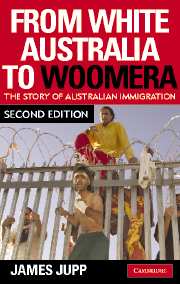Book contents
- Frontmatter
- Contents
- Acronyms and abbreviations
- Introduction
- Chapter 1 Creating an immigrant society, 1788–1972
- Chapter 2 From assimilation to a multicultural society, 1972–2006
- Chapter 3 The Fraser, Hawke and Keating governments, 1975–1996
- Chapter 4 Policy instruments and institutions
- Chapter 5 Multicultural policy
- Chapter 6 The attack on multiculturalism
- Chapter 7 The impact of One Nation
- Chapter 8 Economic rationalism
- Chapter 9 Sustainability and population policy
- Chapter 10 Refugees and asylum seekers
- Chapter 11 Immigration in a global world
- Appendix I Chronology: 1972–2007
- Appendix II Ministers for immigration, departmental secretaries and gross annual settler intake, 1973–2006
- References
- Index
Chapter 1 - Creating an immigrant society, 1788–1972
Published online by Cambridge University Press: 03 May 2010
- Frontmatter
- Contents
- Acronyms and abbreviations
- Introduction
- Chapter 1 Creating an immigrant society, 1788–1972
- Chapter 2 From assimilation to a multicultural society, 1972–2006
- Chapter 3 The Fraser, Hawke and Keating governments, 1975–1996
- Chapter 4 Policy instruments and institutions
- Chapter 5 Multicultural policy
- Chapter 6 The attack on multiculturalism
- Chapter 7 The impact of One Nation
- Chapter 8 Economic rationalism
- Chapter 9 Sustainability and population policy
- Chapter 10 Refugees and asylum seekers
- Chapter 11 Immigration in a global world
- Appendix I Chronology: 1972–2007
- Appendix II Ministers for immigration, departmental secretaries and gross annual settler intake, 1973–2006
- References
- Index
Summary
Australia is an immigrant society. Without continual immigration the modern, urbanised and affluent society of today could not have been created. Australia is also the product of conscious social engineering to create a particular kind of society. This distinguishes it from other immigrant societies such as the United States, Argentina or even Canada, where the role of the state was less apparent and where private initiative was more important. Almost alone, with New Zealand, Australian governments set out to create a specific model using immigration and the introduction of overseas capital and technology. They are still doing so today, although naturally the goals and methods have changed over the past two centuries.
A new Britannia
Australia and New Zealand are the two ‘most British’ societies in the world outside the United Kingdom. Australia is the ‘most Irish’ society outside Ireland, although the United States attracted vastly more Irish immigrants to a much larger society. New Zealand might contest with Canada for the title of the ‘most Scottish’ society outside Scotland. The often repeated and incorrect claim that Australia is the ‘most multicultural society in the world’ does not bear close inspection. It is certainly much more multicultural than it was fifty years ago when the post-war immigration program began. It is even more multicultural than it was at Federation in 1901, when 20 per cent of its people were overseas-born and it had large German and Chinese minorities.
- Type
- Chapter
- Information
- From White Australia to WoomeraThe Story of Australian Immigration, pp. 6 - 18Publisher: Cambridge University PressPrint publication year: 2007



